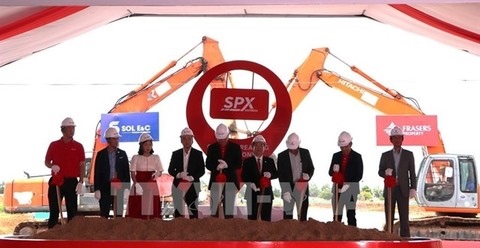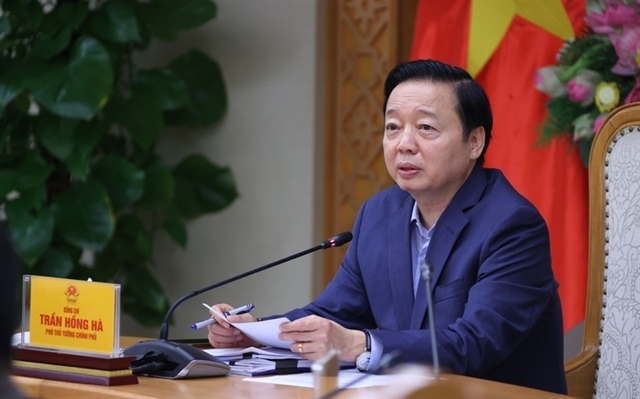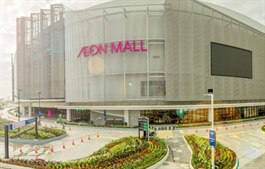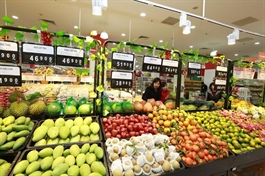Better infrastructure is way to absorb surge in renewable energy production: experts
Better infrastructure is way to absorb surge in renewable energy production: experts
Storing renewable energy in batteries and pumped storage of water to generate power, and improving transmission capacity are keys for Vietnam to foster renewable energy, according to experts.
Nguyen Duc Ninh, director of the National Load Dispatch Center, said earlier this month Vietnam plans to reduce its renewable energy output by 1.3 billion kilowatt hours this year since it lacks transmission capacity.
Installed solar power capacity reached 19,400 MWp by the end of last year, or 25 percent of total power capacity.
Dr Hang Dao, a sustainable energy expert at the World Resources Institute (WRI), said the reason Vietnam has solar energy surplus is the country's electric grid and infrastructure are quite weak, and so energy is not transmitted to locations where needed.
The national grid is out of date and needs to be upgraded, but it would take time to install a modern network, and while waiting for it the country could focus on short-term storage plans, said Hang.
The first option is batteries in different forms and scales that can be used for various kinds of electric vehicles like bikes and cars now and the metro in the near future, she said.
"The technology is already fairly mature globally, and Vietnam's task is to adopt and apply it."
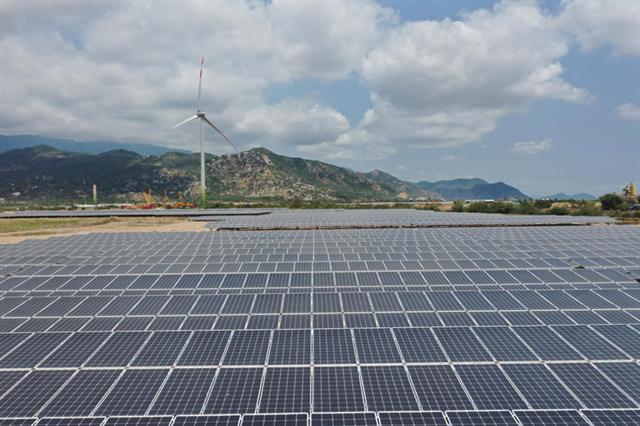
Solar panels seen at a power plant in Tay Ninh Province, southern Vietnam. Photo by VnExpress/Quynh Tran.
|
Professor Andrew Blakers of the Research School of Electrical, Energy and Materials Engineering, College of Engineering and Computer Science, Australian National University, said Vietnam should invest in batteries with a huge storage capacity, such as those used for overnight storage, instead of one-hour batteries, because the country has great potential in solar and wind energy.
But overnight storage batteries are 12-24 times more expensive than a one-hour battery, he said.
Battery storage is the best option for Vietnam, and so it should make a decision to invest in electric vehicles since they have large batteries and can soak up a lot of sunshine, he said.
Besides, vehicle owners would pay for the batteries in that case, he pointed out.
But Prof Chris Greig of the Andlinger Center for Energy and the Environment, Princeton University, the U.S., said this choice is relatively expensive since a battery with a storage capacity of four or six hours costs around $400 per kilowatt hour.
Greig suggested a second option for Vietnam: pumped storage at hydropower plants. The plants could use renewable energy to pump water up mountains and dams during low-demand periods and release it during peak periods to generate electricity, and this technique could be used to store power for a longer time, he said.
"With its good hydropower resources, I think that has good potential for Vietnam."
The country should make hydropower plants and wind and solar plants partners, he suggested.
Pumped storage depends on how far hydropower resources are from solar plants, and Vietnam needs adequate transmission facilities, he said.
Long-term solutions
Hang said the country's transmission and distribution infrastructure is not equipped to cope with the rapid growth in renewables, but it would be a financial burden for the government to improve the power grid by itself.
It is time for allowing private investment in the power sector, including in transmission and distribution, she said.
It means the Electricity Law needs to be amended to eliminate the government's monopoly, and this is in line with the Politburo's Resolution No. 55 on strategic orientations for national energy development for until 2030, she said.
The need for private power plants to build their own transmission lines has become pressing in light of Vietnam Electricity (EVN)’s difficulty in developing infrastructure, she said.
There is no shortage of international investors in renewable energy projects in Vietnam, she pointed out.
Greig said if a country wants to invest in solar and wind plants, it has to invest more in the grid if their sites are far from places that have demand for power.
The low capacity of the grid is a common problem when a nation’s renewable power production grows quickly, he said.
Ninh from the National Load Dispatch Center of Vietnam said there was a surge in renewable energy production last year, especially in the rooftop segment, which saw capacity rise by 66 percent to 10,000 megawatt peak (MWp) between June and December.
This caused an oversupply, with overloads recorded in the central provinces of Ninh Thuan and Binh Thuan, forcing EVN to reduce purchase of solar energy by 365 million kilowatt-hours in 2020.
Greig said the main demand for power is in the big cities like Ho Chi Minh City, Hanoi, Da Nang, and Can Tho, and so Vietnam needs to make large investments in power transmission infrastructure.
Furthermore, if it wants to expand solar and wind production to significant levels, it should not do this independently of the national system, but make it part of a plan that includes a national grid, existing generators and the way the market operates, he said.
It should have a robust national system and ensure that provincial plans are consistent with national plans, he said.
"Vietnam has to have a very clear plan for where you are today and where you want to be in 2050."
He said Vietnam’s power generation would grow rapidly for two reasons: its rapidly growing economy, leading to rising electricity demand, and the move by users from fuel to electricity, like cars.
"In the next few years maybe Vietnam will double the amount of solar energy. And then the challenges will become much more significant."
As for the role of the private sector in developing renewables, he said that there are always trade-offs when a country deregulates or privatizes the electricity sector because private operators do not necessarily act in the national interest.
But ownership is not the important thing, the country's energy security is, he said.
Great potential
Blakers said Vietnam has the best solar and wind power potential in Southeast Asia.
He cited a recent study he did with colleagues that found Vietnam has enormous off-river pumped storage potential of 200 Terawatt-hours at 6,000 sites.
This is about 100 times the total electricity Vietnam needs, he said.
A combination of these is much better than what its neighbors possess, he said, pointing for instance to Indonesia which has no wind because it is on the equator.
Other countries in Southeast Asia also lack winds and mountains for pumped storage while Vietnam has it all, he said.
It needs to combine all these like utility-scale batteries, pumped storage and electric vehicles, and improve transmission capacity, he said.
That would mean the need for new coal-fired power stations and hydroelectric dams would disappear, he said.
"Vietnam will find it easier to get to 100 percent renewable electricity than almost any other country. Vietnam could have the cheapest electricity in Asia."



